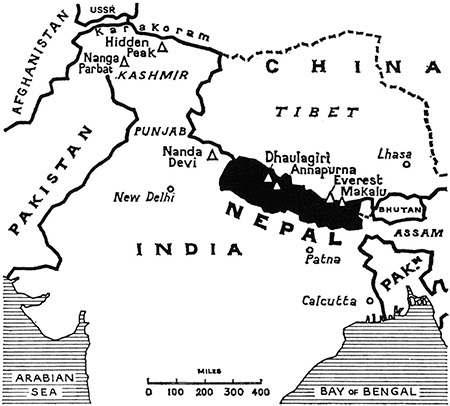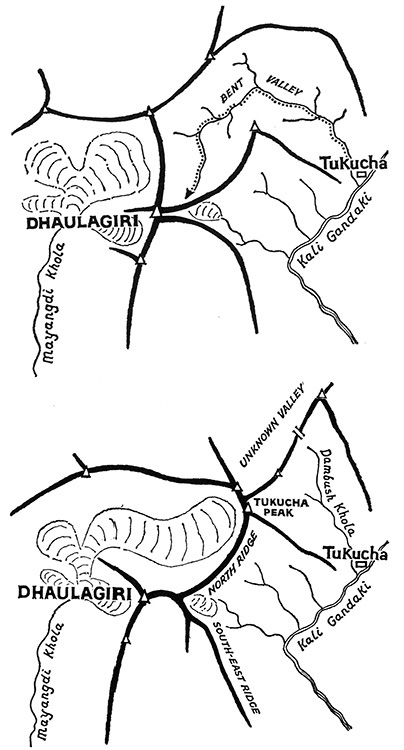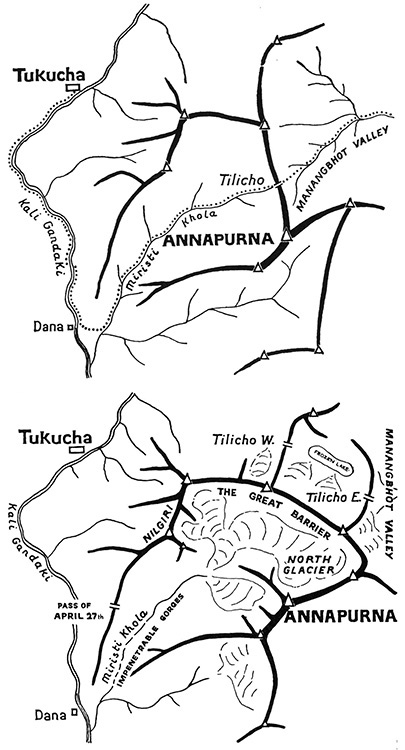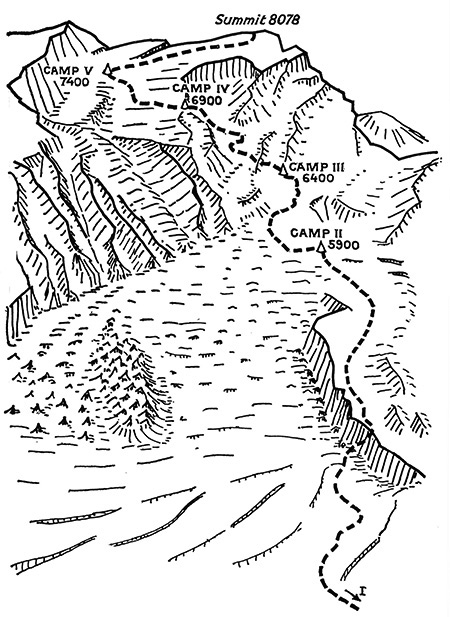Conquistadors of the Useless (48 page)
Read Conquistadors of the Useless Online
Authors: Geoffrey Sutton Lionel Terray David Roberts

In his intelligent and sensitive obituary, Schatz cites the final assault on Chomolonzo, of which I was a witness, as best illustrating Couzy's personality. Looking back I agree with him that in this secret trial by combat our friend showed his quality still more than on the most desperate faces in the Alps, and it is with this recollection that I would like to leave him. I can however add one or two details which seem to me to enhance the value of his performance. Throughout the whole of the previous night we had been battered by the most violent tempest I have ever known in the Himalayas. Our tent seemed likely to rip in two at any moment, and some of the seams did in fact yield under the sledge-hammer blows of the wind. At dawn the temperature was minus-twenty-seven degrees Centigrade inside the tent. The wind had abated somewhat, but ninety-mile-per-hour gusts still blew us off our feet every so often. Psychological conditions were hardly more favourable, and personally I had no thought but to get down out of it all as quickly as possible. Only Jean's magnetic personality constrained me to follow him like one condemned to the scaffold. There were tears in the Sherpas' eyes when they saw us preparing to set out, so little hope had they of seeing us again!
âLionel is fully in agreement', says Schatz, âin attributing the initiative for this adventure to Jean. The reconnaissance had ended in the virtual certainty of success on Makalu the following summer, but to him such a result seemed to be returning empty-handed. Three miles of icy ridge away lay the giant Chomolonzo without whose head Jean was unwilling to sound the retreat. Surely no Himalayan summit of such stature has ever fallen so quickly and surely as this one, on which they stood that same noon.
âHow Jean's eyes burned when he showed me the photographs, and what modesty he displayed in carefully explaining that the weather report was favourable, the snow in good condition, in fact the whole thing just a matter of going through the motions! There is a particular grandeur in reducing such deeds to a simple scrutiny of the evidence, in seeking excuses for such happy inspiration. Jean was entire. That was the secret of his comportment in the face of danger â for he was without physical fear and always acted as, on mature reflection, he had decided to act â and no doubt the secret of his life.'
1.
Translator's note.
Nanda Devi, 7,816 metres, was climbed in 1938 by Tilman and Odell. The author omits to mention that heights greater than the summit of Annapurna were reached by members of Everest expeditions in the 1920s.
[back]
2.
Translator's note.
Equivalent in those days to very roughly six thousand pounds.
[back]
3.
Translator's note.
Hautes Etudes Commerciales â a business school located in Paris.
[back]
4.
Translator's note.
It may be that the author underestimates the value of training on the relatively short but extremely difficult ice climbs of the Eastern Alps and Scotland.
[back]
5.
Translator's note.
The whole party were experienced mountaineers, more than half of whom had been to the Himalayas before.
[back]
6.
Translator's note.
Now six.
[back]
7.
Translator's note.
The term was actually applied to the best among them. It is a normal British climbing expression for an outstanding climber.
[back]
8.
Author's note.
Two famous British Himalayan explorers and climbers.
[back]
9.
Author's note.
A kind of mild beer made from millet.
[back]
10.
Translator's note.
Kukris â curved Gurkha knives.
[back]
11.
Translator's note.
The sixth and seventh parties were Swiss.
[back]
12.
Author's note.
Barley meal lightly roasted to arrest fermentation.
[back]
13.
Author's note.
A kit including one tent, two sleeping bags and air-mattresses, one spirit cooker, and two billies.
[back]
14.
Author's note.
Frostbite at altitude is not due soley to cold, but also to rarefaction of the air. This causes an increase of red corpuscles. The blood, this thickened, clogs easily in the capillary vessels.
[back]
15. Less than twelve hours return from Envers des Aiguilles.
[back]
16.
Translator's note.
Except, of course, Annapurna.
[back]
17.
Translator's note.
On, it is fair to add, some of the hardest climbs in the Alps.
[back]
18.
Translator's note.
Admission to the Ecole Normale Supérieure and the Polytechnique is a sign of the highest intellectual eminence in France. Their graduates constitute an elite in the national life.
[back]
19.
Translator's note.
A devious character in a play of the same name by de Musset about Florentine life.
[back]
20. Chomolonzo: 7,796 metres or 25,584 feet. Makalu: 8,490 metres or 27,854 feet.
[back]

Map of India and Nepal.

Top: The topography of Dhaulagiri according to the Indian map.
Bottom: The topography of Dhaulagiri as it really is.

Top: The topography of Annapurna according to the Indian map.
Bottom: The topography of Annapurna as it really is.

The north face of Annapurna, showing the route followed. The numbers indicate the sites of the camps. (Heights are given in metres.)
Mountain Ranging
When I disembarked at Orly in July 1950, bearded, astonished at the hysteria of the crowd, and carrying my mutilated friend in my arms, it seemed the end of an episode that was never likely to be repeated. It certainly never occurred to me that a new pattern had been created in my life. Perhaps, one day, I will find the time and the energy to give a detailed account of the second part of my career, but in this already overlarge book I must be content with a brief summary.
It soon became clear that our exploit had excited an interest far exceeding our wildest dreams. The Press, that tyrant of modern times which can make and unmake heroes and legends to its own convenience, gave us the sort of publicity normally reserved for the amatory adventures of film stars and kings. The novel and dramatic aspect of the story, together with its triumphant outcome, made for just the sort of sensationalism on which the public is fed, while the general ignorance of geography caused many to think that we had climbed the highest mountain in the world instead of just the highest so far. Some of our renown, indeed, was probably founded on precisely this confusion.
Deliberately ignoring anything so difficult to understand as teamwork, the papers proceeded to transform Herzog into a national hero, concentrating all their attention on him as a kind of fabulous Big White Chief. The rest of the expedition, including Lachenal, were relegated to the position of mere accessories. Slightly later, in order to renew flagging interest, they picked on me, blowing me up as a sort of cross-grained Hercules with a heart of pure gold. Since then I have been preceded by this awful reputation wherever I go.
The Eigerwand had taught me the transitory nature of journalistic glory. I was in a hurry to get back to the things that really mattered, and I did not wait for the round of victory celebrations. Less than a week after our arrival I was climbing again. Still suffering a bit from cumulative fatigue, I managed nevertheless to guide a client on the first complete traverse from the Col des Hirondelles to the Col du Géant, a two-day expedition across all the points on the summit ridges of the Grandes Jorasses and Arête de Rochefort. It was a remarkably fine summer, and I had more clients than I could cope with. The fatigue continued to build up in my muscles as I forced myself to carry on. By the end of August I was very near exhaustion, but after a few days rest I felt fit enough to consider doing some amateur climbing again.
In mid-September I decided to have a try at the west face of the Aiguille Noire de Peuterey with Francis Aubert, the young friend who had been in Canada with me the winter before. This was a rock climb which had not often been done at that time, and which had acquired a reputation for extreme difficulty. We crossed the Col de l'Innominata at dawn. The descent to the Fresnay glacier on the other side is not difficult enough to require putting on the rope, and in the half-light each followed his own path. Francis noticed that he had got slightly off route and climbed a little way back towards me. I was in the process of giving him some directions when suddenly a large jammed block came out on top of him. For a moment he fought to heave it aside, then peeled off into the three-hundred-foot gulf beneath, and I was left alone on the mountain.
I had several times had to carry down the bodies of men who had fallen a long way in climbing, and during the war comrades had been killed at my side, so that I thought myself pretty well hardened to such sights: but I was wrong. Crazed with grief I called and called to my friend. There came no answer but the sound of the wind.
This experience left me badly shaken for several months, and for the first time I began to doubt. Were the mountains worth such sacrifices? Was my ideal no more than a madman's dream? I made the resolution never again to leave the reasonable, well-worn trails of traditional guiding.
Despite my two years' absence, the Ecole Nationale de Ski et d'Alpinisme invited me to rejoin it as an instructor for the winter. Canada had been an interesting and fruitful experience, but the actual skiing had been disappointing. Throughout my stay there I had dreamed constantly of great hills and long descents. Now I could resist them no longer, and although it meant giving up important material advantages, I decided to stay at Chamonix. Gradually the delights of skiing and competition began to soothe and overlay the memory of the Innominata tragedy. By the time spring came my old longing for action had utterly taken possession of me again. All my wise resolutions of the autumn were thrown to the winds, and I dreamed of nothing but new adventures.
Precisely at this moment came exciting news. Réné Ferlet and some of my friends in Paris were getting up an expedition to one of the most notorious mountains in the Andes, the Fitzroy Peak. This Matterhorn of the south was already well known in France, and pictures in the mountaineering journals had shown it to be a great cone of granite rising in majesty for thousands of feet out of the surrounding wastelands of Patagonia. Several expeditions of proven climbers had already attempted it in vain.
Despite its relatively low altitude of 11,319 feet, none of these expeditions had even succeeded in passing the pedestal on which the mountain stands. So far as they could tell, the final step of some two and a half thousand feet was likely to prove as difficult as the hardest climbs in the Alps, but the real obstacle would be the Patagonian climate. One would be lucky to get a few consecutive fine days even in summer, and the ascent would be rendered extremely dangerous by the bitter cold, the verglas and the sudden, violent hurricanes. These terrible weather conditions had exhausted and discouraged the earlier expeditions even before they reached the foot of the climbing proper.
From the first moment I heard of it I was carried away with enthusiasm for Ferlet's venture. All my old passion for the great climbs came back with a rush. Fitzroy, after all, was the type of the ideal summit such as I had not yet found in the Alps or the Himalayas. Annapurna had given me the excitement of travelling in new lands, the joy of exploration, and almost too much of a good thing when it came to sheer adventure, but the actual climbing had been a disappointment. Tough and thrilling as it was, Himalayan mountaineering, on this mountain at least, seemed something different in kind from âalpinism', which I think of as an essentially individual experience almost like artistic creation. On the world's highest mountains the scale is such that no man can hope to succeed solely by his own efforts. Victory is only secured by a collective undertaking, bringing into play considerable technical resources, and in my eyes the whole business becomes more military than artistic.
My dream, then, was to tackle mountains which would give harder and more complex problems than the Alps, but remain within the scope of a normal rope of two men. The Fitzroy was obviously tailored to my requirements, and no sooner had I heard of Ferlet's project than I wrote asking him if I could join his party, to which he kindly agreed.
With Patagonia being situated in the southern hemisphere the seasons are of course all inverted, and there was no need to set out until the following December. Although there were some months to be passed before going into action I was by no means short of something to do, since the F.F.M. had begun to sponsor lectures illustrated by Ichac's film. They were a prodigious success. Outside the Salle Pleyel over 100,000 persons queued up for one lecture alone out of the forty that were given. In the main provincial centres large crowds milled around the box offices and many people had to be turned away for lack of places.
Herzog and Lachenal, still heavily bandaged, presided over most of these evenings, but all the rest of us did our share too. Some showed quite unexpected talent as speakers, but it has to be confessed that although their sincerity and spontaneity were attractive, the intellectual level of the lecturing was not very high. This in no way affected their success, however, and the crowds continued to bring down the roof. It was hard to tell if they were mesmerised by the grandeur and nobility of the deed, or by the large-scale publicity!
My work at the Ecole Nationale left me little time to take part in this great effort to collect funds for future French expeditions. I went up to Paris for the âfirst night', of course, and somewhat later I gave a few lectures in villages around Chamonix at Maurice Herzog's request. My beginnings as a lecturer were rather comic â indeed the first attempt practically amounted to slapstick.
I had set off from Chamonix after the day's skiing was over, and with no more respite than a good meal was pushed on to the platform in front of the crowd. All I had to do was to give a short briefing on the Himalayas with the aid of some coloured slides, then provide the commentary to Ichac's film. I had no notes, had done no homework, and had not seen the film since the first night a month previously. Needless to say I had the wind up badly despite a certain amount of practice in public speaking in Canada, and was mainly relying on the good will of the public in order not to be hissed.
I forgot half of what I wanted to say during the introduction, but, to my surprise, the applause broke out like a hail storm. Then came the slides. I was expecting the same ones that had been shown at the Salle Pleyel, but these turned out to be a set I had never even seen, and just to cap matters the operator had neglected to arrange them in logical order! First came an unexpected photo of Annapurna, but it was not too difficult to think of some appropriate comment. The next slide showed some gorgeous Nepalese girls. It took me a moment to absorb the shock, then by a rapid piece of mental acrobatics I found a connecting theme, and said loudly:
âWhen it comes to beauty, Nepal has everything. High in the sky rise the most beautiful mountains in the world, while down in the valleys the traveller meets so many of these ravishing creatures that it is hard to force oneself to go on.'
The third shot showed a lorry on the road. I felt as though I was going mad and broke out in a cold sweat, nevertheless I managed to find some far-fetched connection. The fourth was a view of Dhaulagiri, and, recovering my confidence, I explained about our preliminary reconnaissance of that mountain. It was at this moment that the fifth slide appeared: it showed a high diver in the air!
In my panic I could find no possible link between this and the previous views. As the first shock wore off, however, I realised that diver looked just like me, and rather than stand there stupidly saying nothing I blurted out:
âLadies and gentlemen, this muscular, graceful athlete with the lean brown frame is none other than myself.'
After a moment of silence there came a great roar of laughter. The pictures continued to turn up in lunatic order, but this success had given me the confidence to play the clown. The evening turned into a kind of Himalayan Hellzapoppin, with the public rolling in the aisles. At last we came to the film. There could be no mistake now, and I remembered Rébuffat's excellent advice: âLet the pictures speak for themselves.' I therefore simply threw in a relevant or explanatory remark from time to time.
After it was all over I expected a row from the promoters, but on the contrary they were delighted. There was nothing but congratulations and âMy dear fellow, what an original commentary', âHow funny you are', or âYou've given us a most wonderful evening'.
I didn't know in those days that such remarks are not intended to be taken too seriously, but even so I think they exaggerated a bit!
A few weeks later I gave some lectures in central France. The first took place at Thiers. I arrived very late as a consequence of a breakdown, carrying the 16-mm. projector which Lachenal had handed over to me the day before. I was counting on finding a trained operator on the spot to work it, but due to faulty liaison Paris had not informed the local section of the
Club Alpin
that one would be needed. The hall was already full and people were beginning to stamp their feet, so I asked to see the operator at once. Everyone was amazed.
âWhat, you don't work the machine yourself?'
âI haven't the remotest idea how it works', I replied with complete sincerity.
There was a complete panic. Nobody knew how to make the machine go. Should they refund the entrance fees? But really, that would be altogether too bad for the prestige of the C.A.F. I decided to take a chance on starting the introduction while they were tinkering with the projector. Presently I received a discreet message to spin it out as long as I could, as an expert was on the way. After I had finished all the slides I started telling stories, but presently I ran out of inspiration. Things were going from bad to worse when suddenly the lights went out and the title appeared on the screen, only to disappear at once, leaving the hall in darkness again. For some unknown reason nobody turned the lights on. I tried to tell more stories, but the public's patience was at an end. People were stamping, somebody called out âRefund', others were booing. Everything was going wrong when suddenly a ray of light shot through the room and some of the credits appeared on the screen. The audience heaved a great sigh of satisfaction which filled my harrassed soul with a warm glow of gratitude. No sooner had I felt this than the light went out again.
âThis time', I thought, âit's the end.' I felt utterly crushed and ashamed. The lights went on and the crowd rose to go. Before they had reached the door the lights went out for the last time, the film appeared on the screen, and contrary to all expectation the whole thing ran through without any further hitch.
When the skiing season was over the Himalayan Committee asked me to undertake a series of lectures lasting a month, which I accepted the more willingly on account of a good expense allowance and salary. My few experiences during the winter, however, had given me no idea of what I was letting myself in for. The promoter, obviously more concerned with his profits than with the convenience of the lecturer, had arranged a programme of almost impossible density. Apart from the regular evening lecture to an adult audience I also had to give one and sometimes two morning sessions to schools. In addition I had to work all the projection apparatus myself, suffer numerous parties, banquets and receptions, and, of course, drive my old Renault from place to place. Sometimes I had to cover considerable distances, since the programme had been dictated by (sometimes rather odd) commercial considerations rather than geographical ones. Thus I had to speak one day at Grenoble, the next at Annecy, and the one after at Valence.